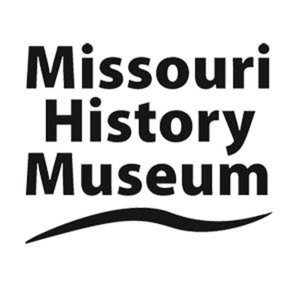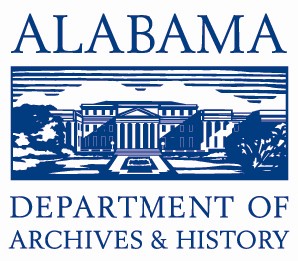from Apr. 14, 1865
Amos Madden Thayer Diary
-
Full Title
Diary of Amos Madden Thayer, March 29-May 12, 1865
-
Description
Amos Madden Thayer was born October 10, 1841, in Chautauqua County, New York. Soon after his graduation from college in 1862, he was commissioned 2nd lieutenant of Company D, 112th New York Infantry. He later transferred to the United States Signal Corps, where he served as 1st lieutenant until the close of the war. Following the war he moved to St. Louis, where he passed the bar and later spent several years as a judge. He died April 24, 1905, in St. Louis.
Includes brief accounts of movements and military operations during the Appomattox Campaign; account of march from Burneville, Virginia, to Washington, D.C.; and final messages that Thayer sent and received, which passed between Generals Meade and Humphreys on April 9, 1865, during the Battle of Sailor's Creek. Also includes letterbook of correspondence from Thayer's law practice in Saint Louis, 1866-1876.
-
Source
Missouri History Museum
-
Rights
This item is in the public domain.
-
Tags
-
Cite this Item
Thayer, Amos Madden, 1841-1905. "Diary of Amos Madden Thayer, March 29-May 12, 1865". Remembering Lincoln. Web. Accessed July 7, 2025. https://rememberinglincoln.fords.org/node/313
from Apr. 14, 1865
Diary of Amos Madden Thayer, March 29-May 12, 1865
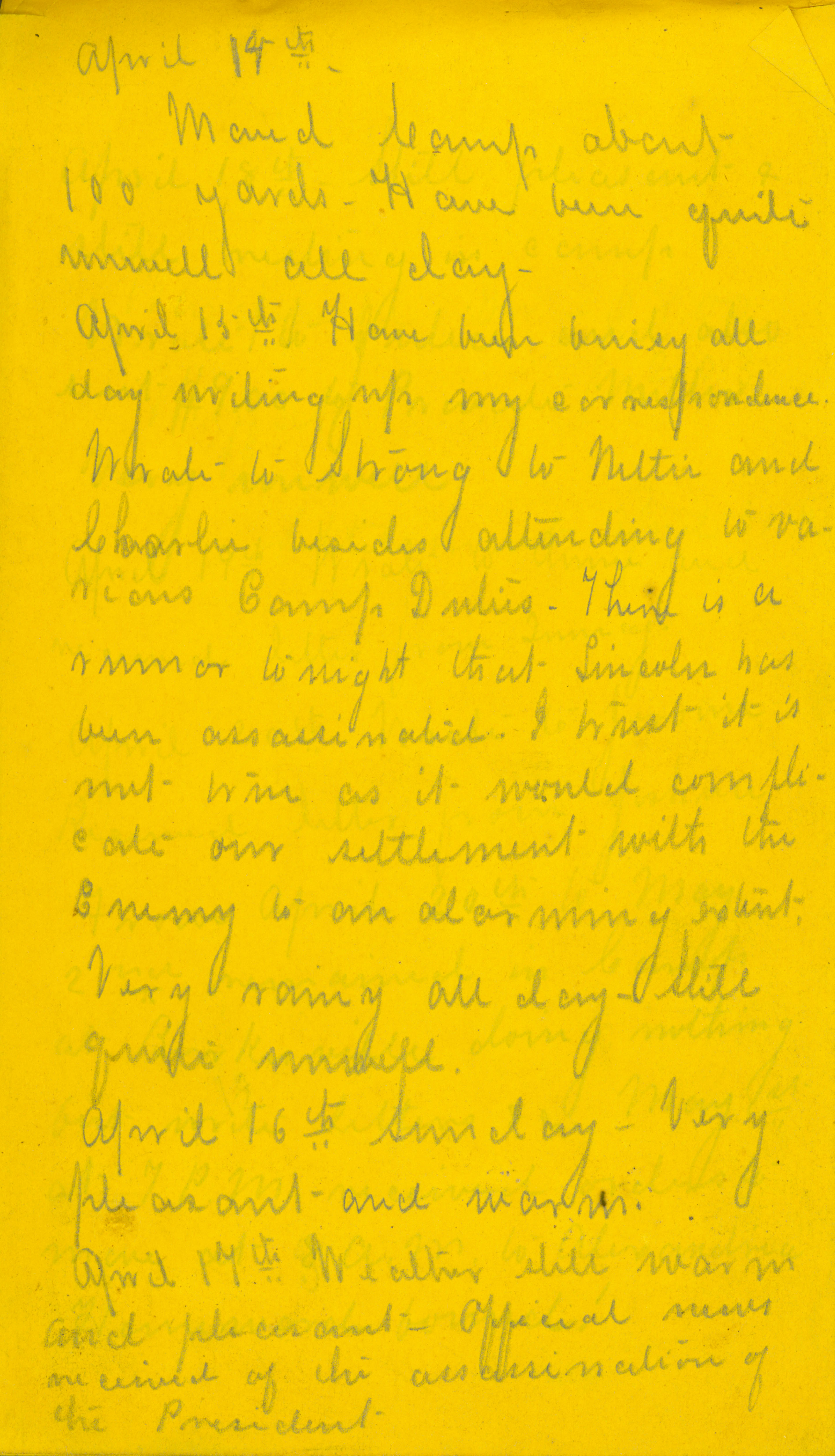
-
Description
Amos Madden Thayer was born October 10, 1841, in Chautauqua County, New York. Soon after his graduation from college in 1862, he was commissioned 2nd lieutenant of Company D, 112th New York Infantry. He later transferred to the United States Signal Corps, where he served as 1st lieutenant until the close of the war. Following the war he moved to St. Louis, where he passed the bar and later spent several years as a judge. He died April 24, 1905, in St. Louis.
Includes brief accounts of movements and military operations during the Appomattox Campaign; account of march from Burneville, Virginia, to Washington, D.C.; and final messages that Thayer sent and received, which passed between Generals Meade and Humphreys on April 9, 1865, during the Battle of Sailor's Creek. Also includes letterbook of correspondence from Thayer's law practice in Saint Louis, 1866-1876.
-
Source
Missouri History Museum
-
Rights
This item is in the public domain.
-
Creator
Thayer, Amos Madden, 1841-1905
-
Date
April 14, 1865
from Apr. 15, 1865
Diary of William Ellis Stork, Volume 1, Preston, Minnesota
-
Full Title
Diary of William Ellis Stork, Volume 1, Preston, Minnesota
-
Description
Diary of William Ellis Stork as he recounts his life and his reactions to major events.
-
Transcription
"Got news of Lincoln’s death and the attempted assassination of Sen [??]" (pg. 30)
"1865 April 3. Richmond & Peters burg was evacuated by the rebels & taken possession of by our forces April 9th and 10th Gen[eral] Lee surrendered the army of north Virginia to Grant Lincoln died was shot at a Theatre April 14th & died April 15th. Born July 12th 1809 Age at death death 55 y[ea]rs 9 m[onths] 3 d[ays] 16 m[inutes] President of the United States [inked line] Andrew Johnson took the oath of office as President April 15th at 11 o’clock A.M. [inked line] J. Wilkes Booth & his accomplice Harrold the murderers of President Lincoln was found in a barn at a Mr Garrotts 3 Ms[miles] from Bowling Green towards Port Royal in Virginia Booth was shot in the barn & died at 7 A.M. April 26th Harrold was taken to Washington President Johnson in his Proclamation of May 2nd after stating It appears from evidence in the burden[?] of military justice that the atrocious murder of the late President & attempted murder of W[illiam] H. Seward secretary of State incited, concerted, of & between Jefferson Davis late of Richmond Va[Virginia] & Jacob Thompson Clement Clay Beverly Tucker George N. Danders W.C. Cleary & others rebels & traitors against the Government of the United States, Harbored in Canada now therefore to the end" (pg. 74)
-
Source
Minnesota Reflections
-
Rights
Use of this item for research, teaching, and private study is permitted with proper citation and attribution. Reproduction of this item for publication, broadcast, or commercial use requires written permission.
-
Tags
-
Cite this Item
Stork, William Ellis, 1841 - 1938. "Diary of William Ellis Stork, Volume 1, Preston, Minnesota". Remembering Lincoln. Web. Accessed July 7, 2025. https://rememberinglincoln.fords.org/node/319
from Apr. 15, 1865
Diary of William Ellis Stork, Volume 1, Preston, Minnesota
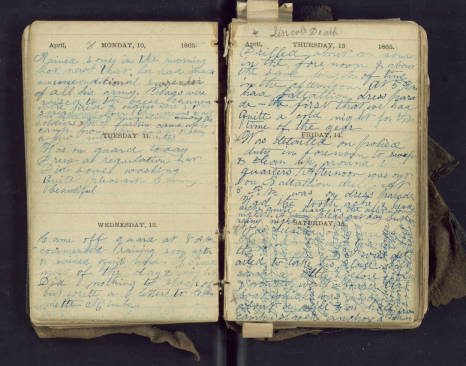
-
Description
Diary of William Ellis Stork as he recounts his life and his reactions to major events.
-
Source
Minnesota Reflections
-
Rights
Use of this item for research, teaching, and private study is permitted with proper citation and attribution. Reproduction of this item for publication, broadcast, or commercial use requires written permission.
-
Creator
Stork, William Ellis, 1841 - 1938
-
Date
April 15, 1865
from Jan. 1, 1907
Alice Strickler Keyes diary entry
-
Full Title
Alice Strickler Keyes diary entry
-
Description
Alice Strickler Keyes eyewitness account of the day that Lincoln’s funeral train stopped in Columbus, Ohio, on its way to Springfield, Illinois, where the remains of the president and those of his son Willie would be buried. This account is an excerpt from the Alice Strickler Keyes diary passage in the Altrurian Club of Columbus, Ohio President's Book.
-
Transcription
[Page 1]
25
These grounds, at the head of State street, it was so far from the town and in such a swampy and unimproved district, that it too was dubbed “Swayne’s Folly.” Noah Swayne became most widely known as Justice of the Supreme Court of the United States.
His home at the head of State street was later occupied by J. Ewing Miller. Its site is now that of the Carnegie Library.
Before the “Insane Asylum” burned, the terminus of all our walks eastward, was the great flat boulder, that still lies on the sidewalk in the east Broad street, east of Jefferson Avenue.
A little farther east the Asylum Grounds ended, and not far beyond, lay “Riley’s Woods,” and the open country.
In April, 1865, Columbus with the rest of The Nation was celebrating the “Fall of Fort Sumpter,” the surrender of General Lee, and the End of the “Civil War.” There was great rejoicing.
April 14th was appointed by Governor Brough as a day of thanksgiving. On that day there were services in the churches in the morning;—in the afternoon
[Page 2]
26
and evening everything was done that is possible on such occasions to express the joy of the citizens. The town was lavishly decorated.
The next morning, April 15th all this joy was turned to sorrow when the news of President Lincoln’s assassination reached the city. The emblems of Victory gave place to those of mourning for the fallen Chief.
It was learned a few days later, that the funeral train on its way to Springfield, Illinois, would stop in Columbus, and that the body of the President would lie in state for one day, in the Rotunda of the Capitol.
At school we were told that the city Fire Department would be in the procession to meet the train at the station, and that a number of young girls, dressed in deep mourning were wanted—one to stand beside each driver on the fire engines, and many others to ride on the large “Hook and Ladder” wagon, reconstructed for the occasion.
[Page 3]
27
This plan was carried out. Forty-two school girls of varying ages, of whom I was one, rode on this car, massed around one of our teachers (Miss Sarah Smith) who was heavily draped in black and represented “Columbia.”
After the coffin of President Lincoln was placed on the splendid funeral car, the procession started back on its route through the streets of the city.
At intervals the black robed girls on the float, led by their teacher, sang verses from dirge-like hymns.
When the procession stopped at the gate of the Capitol, these girls left their float and were led into the building, and past the coffin of the President. It is said over fifty thousand people viewed “the remains” that day.
The catalogue used to carry the body of President Lincoln had a canopy shaped like a pagoda. It was large, covered with black cloth, festooned, and trimmed with silver fringe. It was drawn by six white horses with large black plumes on their heads. The horses had a covering of black cloth edged with silver fringe, and each horse was led by a groom dressed in black.
[Page 4]
28
The silver fringe used to trim the funeral car of President Lincoln in Columbus, was afterward turned over to women of one of the church societies, to make into souvenirs to be sold, and I was able to secure a piece of it.
The historian of the “Altrurian Club” (Mrs. Cope) has asked for a small portion of the fringe to be attached to this record of my recollections, and I am happy to give this tiny, precious relic to “Altrurian Club,” of which I am a charter member, and through all the years of its existence, without a break, a constant and loyal member.
Alice S. Keyes
(Mrs. Elias A. Keyes.)
[piece of silver fringe attached]
[Transcription by McCaela Michas]
-
Source
-
Rights
Use of this item for research, teaching, and private study is permitted with proper citation and attribution, as Courtesy of the Ohio History Connection, Abraham Lincoln Presidential Collection . Reproduction of this item for publication, broadcast, or commercial use requires written permission. For permission, please see this web page.
-
Tags
-
Cite this Item
Keyes, Alice Strickler. "Alice Strickler Keyes diary entry". Remembering Lincoln. Web. Accessed July 7, 2025. https://rememberinglincoln.fords.org/node/282
from Jan. 1, 1907
Alice Strickler Keyes diary entry
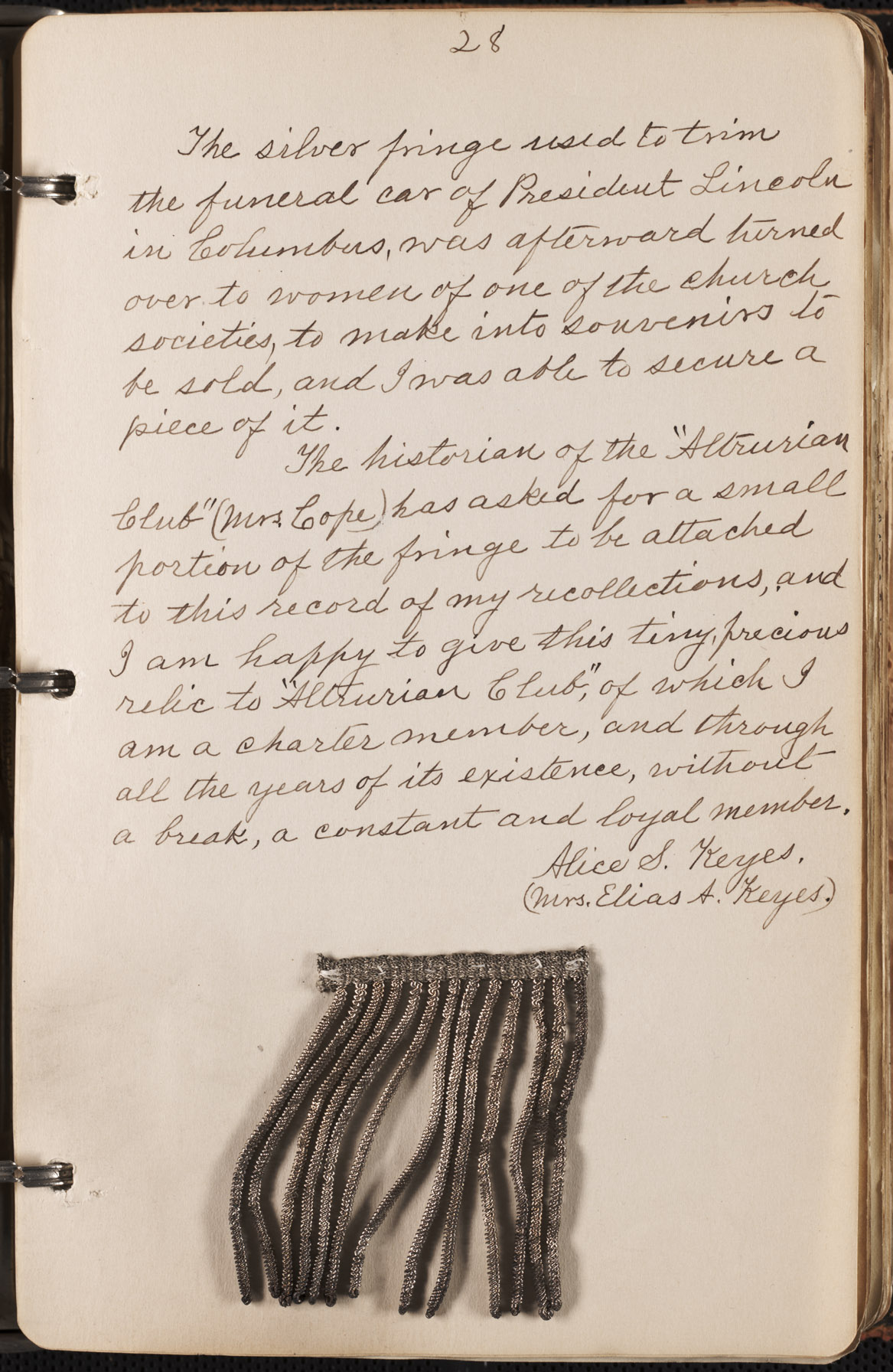
-
Description
Alice Strickler Keyes eyewitness account of the day that Lincoln’s funeral train stopped in Columbus, Ohio, on its way to Springfield, Illinois, where the remains of the president and those of his son Willie would be buried. This account is an excerpt from the Alice Strickler Keyes diary passage in the Altrurian Club of Columbus, Ohio President's Book.
-
Source
-
Rights
Use of this item for research, teaching, and private study is permitted with proper citation and attribution, as Courtesy of the Ohio History Connection, Abraham Lincoln Presidential Collection . Reproduction of this item for publication, broadcast, or commercial use requires written permission. For permission, please see this web page.
-
Creator
Keyes, Alice Strickler
-
Date
January 1, 1907
from Apr. 16, 1865
Mary Jane Chadick Diary
-
Full Title
Excerpts from the diary of Mary Jane Chadick, published in "The Alabama Historical Quarterly", Volume 9, Number 2 (Summer 1947).
-
Description
In her entry for April 16, 1865, Chadick discusses local reaction to the death of Lincoln, including a military order calling for the punishment of "all persons exalting the death of President Lincoln." She also mentions the attempted assassination of Secretary of State Seward. An introduction by the journal editor is included. (The original diary is located at the University of Arkansas Libraries; see "Source" field for specific location information.)
-
Source
Mary Jane Chadick Journal, Fordyce Family Papers (MC 1311), Box 4, Folder 4. Special Collections, University of Arkansas Libraries, Fayetteville. Finding aid for this collection is available here.
(A transcript is available at the Alabama Department of Archives and History, collection number SPR69. Catalog record for this title is available here.)
-
Rights
Use of this item for research, teaching and private study is permitted with proper citation and attribution, as defined here. Reproduction of this item for publication, broadcast or commercial use requires written permission. For permission, please contact the Alabama Department of Archives and History. -
Tags
-
Cite this Item
Chadick, Mary Jane. "Excerpts from the diary of Mary Jane Chadick, published in "The Alabama Historical Quarterly", Volume 9, Number 2 (Summer 1947).". Remembering Lincoln. Web. Accessed July 7, 2025. https://rememberinglincoln.fords.org/node/212
from Apr. 16, 1865
Excerpts from the diary of Mary Jane Chadick, published in "The Alabama Historical Quarterly", Volume 9, Number 2 (Summer 1947).
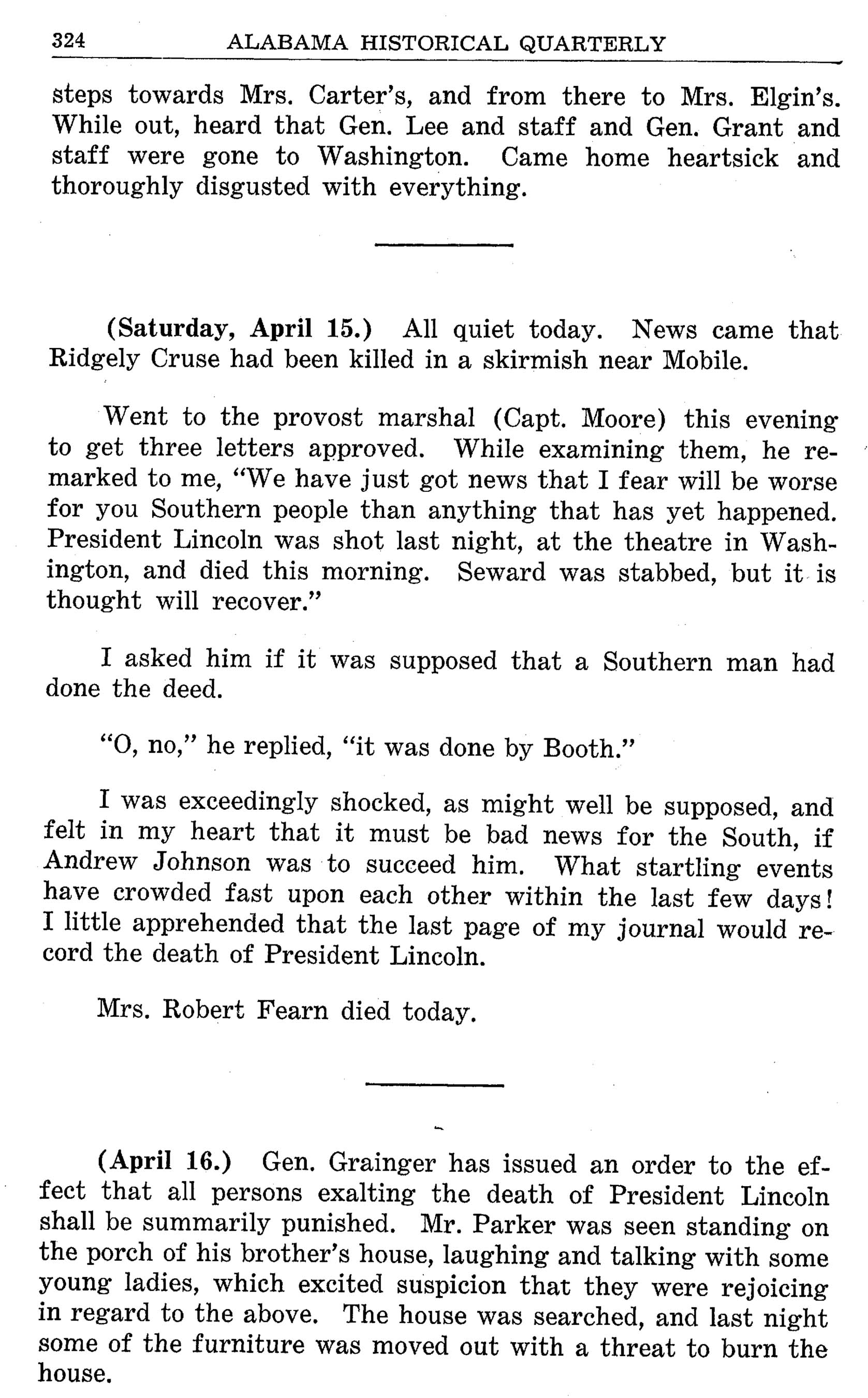
-
Description
In her entry for April 16, 1865, Chadick discusses local reaction to the death of Lincoln, including a military order calling for the punishment of "all persons exalting the death of President Lincoln." She also mentions the attempted assassination of Secretary of State Seward. An introduction by the journal editor is included. (The original diary is located at the University of Arkansas Libraries; see "Source" field for specific location information.)
-
Source
Mary Jane Chadick Journal, Fordyce Family Papers (MC 1311), Box 4, Folder 4. Special Collections, University of Arkansas Libraries, Fayetteville. Finding aid for this collection is available here.
(A transcript is available at the Alabama Department of Archives and History, collection number SPR69. Catalog record for this title is available here.)
-
Rights
Use of this item for research, teaching and private study is permitted with proper citation and attribution, as defined here. Reproduction of this item for publication, broadcast or commercial use requires written permission. For permission, please contact the Alabama Department of Archives and History. -
Creator
Chadick, Mary Jane
-
Date
April 16, 1865
